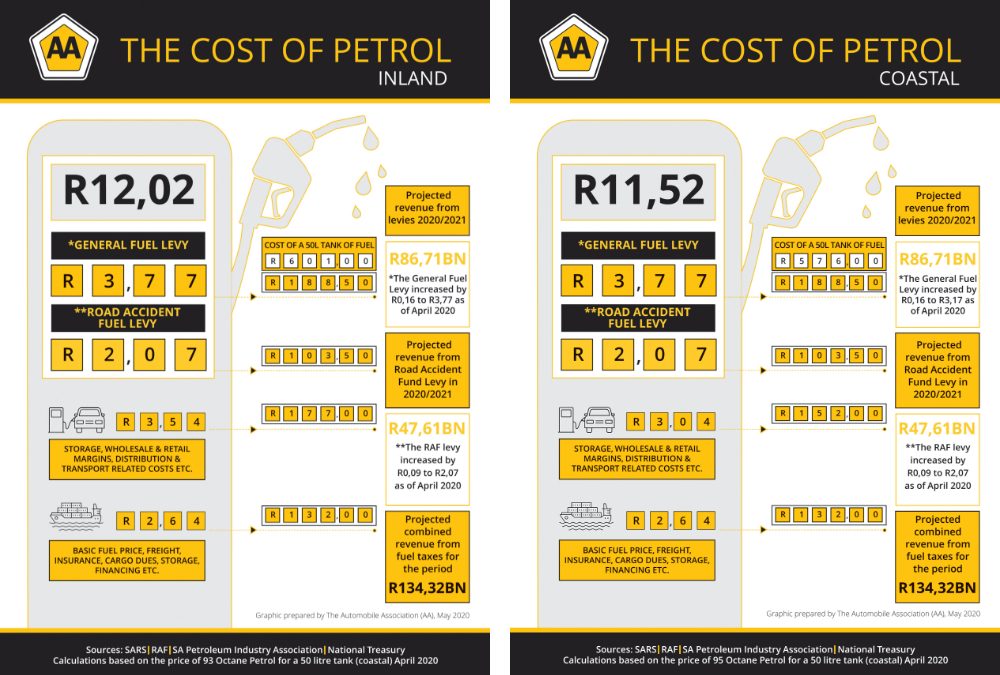South Africa’s fuel price is comprised of many different elements, some of which make fuel in the country more expensive than that in neighbouring countries to which South Africa exports. The AA publishes an annual breakdown of the fuel price to give South African consumers and motorists a snapshot of the cost composition of every litre of petrol inland and at the coast.
The figures used are based on 93 octane fuel (inland) and 95 octane (coastal). It must be noted that the dramatic drop in fuel prices in April and May are record decreases, and will unlikely be seen soon again, if ever. And while these figures bring the overall basic fuel price down, the data relating to the taxes does not change monthly, and remains constant from April to April.
The two main taxes paid on every litre of fuel are the General Fuel Levy (GFL) and the Road Accident Fund Levy (RAF). Increases to these taxes are announced by the Finance Minister in his annual Budget speech in February and come into effect in April. The AA has always raised concerns that increases to these levies which are consistently above inflation ultimately hurt the country’s poorest citizens, particularly as many of these citizens rely on public transport; an increase to the levies inevitably results in an increase to public transport rates.
Increases to fuel prices also mean an increases to goods which are transported across the country as operators recover these higher input costs through increases which are passed to consumers.
The fuel price in South Africa is comprised of four main elements:
The GFL
RAF Levy
Basic Fuel Price (freight and insurance costs, cargo dues, storage and financing)
Wholesale and retail margins, and distribution and transport costs
Currently the GFL is R3.77 which represents 31 percent of a litre of fuel inland (calculated against the current cost of R12.02/litre), and 32 percent of a litre of fuel at the coast (calculated against the current cost of R11.52/litre). Similarly, at its current of R2.07 a litre, the RAF Levy represents between 17 and 18 percent on every litre of fuel sold.
Combined the levies total R5.84 – which remains the same for both inland and coastal prices. Collectively, at the current low prices for fuel because of the record decreases, these levies comprise a whopping 48 to 50 percent of every litre of fuel sold in the country. Together government is projected to gather a total of around R135 billion from these levies with around R87bn coming from the GFL (which goes directly to Treasury and which can be used for any purpose the government determines), and R48bn coming from the RAF Levy.
In South Africa the fuel price is adjusted on the first Wednesday of every month and is determined by two main factors: the Rand/US Dollar exchange rate (how fuel is purchased), and international petroleum prices (how much the fuel costs to purchase).
The Basic Fuel Price (BFP) is calculated based on costs associated with shipping petroleum products to South African from the Mediterranean area, Arab Gulf, and Singapore. These costs include insurance, storage, and wharfage (the cost to harbour facilities when off-loading petroleum products into storage). The current BFP is R2.64, which is dramatically lower than it was before the lockdown started.
Other costs associated with the petrol price include transport costs (from the harbour to inland areas, which accounts for the difference in price between coastal and inland prices), custom and excise duties, retail margins paid to fuel station owners (currently R2.11 on every litre sold), and secondary storage costs. These costs currently total R3.54 for inland petrol and R3.02 for coastal petrol.
Using the current data, filling a 50 litre tank of fuel inland (93 octane) will cost R601 and R576 at the coast (95 octane). It must be remembered that this is a relatively low cost because the price of fuel is at levels last seen in 2016.
However, with economic activity slowly beginning to pick up worldwide, the cost of international petroleum is expected to also slowly increase. This will have a knock-effect on local prices which will also steadily increase.
The AA releases a forecast for the change of fuel prices in the middle of every month, and again the end of every month ahead of the official announcement by government.
About The Automobile Association of South Africa
The Automobile Association (AA) has been the trusted champion of the South African motorist and traveller for over 85 years. Along with our AA Accredited Sales Agents located countrywide, the AA offers access to over 50 benefits on 1 card as well as other travel and mobility services that extend far beyond 24-hour roadside assistance – from technical and legal advice, to emergency rescue services, roadside security and a mobile app suite. The AA offers specialised apprenticeships to help motor industry players build in-house skill, and short skill courses for individuals.
The Automobile Association of South Africa is a member of the Federation Internationale de l’Automobile (FIA) and the Alliance Internationale de Tourisme (AIT).
For more information please visit www.aa.co.za or aasa.mobi, or contact:
Automobile Association of South Africa (AA)
AA Public Affairs
011 799 1126 or 083 386 6954
press@aasa.co.za

